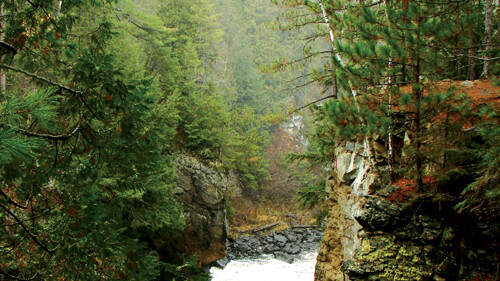The Other Eau Claire(s)
our quest to prove we’re the coolest of the Claires

Eau Claire Gorge in Ontario, Canada is OK.
But confluences are cooler, right?
If you’ve ever typed Eau Claire into a search engine, you know that ours isn’t the only one out there. That got us thinking: What makes us unique? Are we even the best Eau Claire? So, we compiled all the information we could find about the others, and we’ll let you decide …
Eau Claire, Pennsylvania
Borough of Butler CountyPopulation: 350 (as of 2000)
Closest Body of Water: Allegheny River
Eau Claire, Pennsylvania is definitely representative of small town America. With a mere population of around 350 people, 16 percent below the poverty line (just above us), 50 percent identifying themselves as Catholic, and the vast majority Republican voters. Located about an hour away from Pittsburgh, it is not too far from a major urban center. If you want to go to Philadelphia, though, it’s a long 260-mile drive away.
Eau Claire, Michigan
Located in Berrien CountyPopulation: 656 (as of 2000)
Closest Body of Water: St. Joseph River and Clear Water Creek
Eau Claire, Michigan is known for its rolling hills of fruit trees and grape vines. Visitors travel from all over the state to partake in the city’s annual 4th of July Cherry Festival where there are food stands, sidewalk sales, and parades – all in celebration of a variety of produce. The Tree-Mendus fruit farm attracts people from all over the state as well.
Eau Claire, South Carolina
One of 40 neighborhoods in the northern part of Columbia, the state capitolClosest Body of Water: Congaree River
Eau Claire is located conveniently near the Columbia Museum of Art and the McKissick Museum, housing collections in material culture, natural science, and decorative and fine art. For history lovers, it is also located near the boyhood home of former president Woodrow Wilson, as his father taught at Columbia Theological Seminary. For those who enjoy food and art, the annual Ribs and Renaissance event is a Colombia favorite. There are crafts, activities, art sales, plenty of food vendors, and of course, lots of BBQ ribs.
Eau Claire, Alberta (Canada)
Neighborhood of CalgaryPopulation: 1,717 (as of 2006)
Closest Body of Water: The Bow River
The name Eau Claire was derived from one of Calgary’s earliest industries and, believe it or not, it’s because of a sawmill transplanted from right here in our very own Eau Claire, WI, and staffed by Norwegian mill workers. Eau Claire is made up of 32 percent immigrants, adding rich diversity to the community. The city consists of a mixture of riverside condos, shopping districts, restaurants, and a public plaza and urban parkland. It also runs a popular festival district made up of Calgary folk music, Shakespeare in the Park, and various business happenings. But the focal point of the neighborhood is the Eau Claire market, containing several unique and one-of-a-kind shops, galleries, and restaurants.
Eau Claire, Ontario (Canada)
Located in the Calvin, Ontario TownshipPopulation: 608 (as of 2006)
Closest Body of Water: Lake Talon and Amable du Fond River
This Eau Claire community was named after Delino Dexter Calvin, a prominent lumber merchant previously residing in the area. The location is environmentally beautiful as it is home to the Eau Claire gorge, a popular tourist destination located along the Amable du Fond River. You can find it within the Eau Claire Gorge Conservation area, a park preserving the environment’s natural and historic features.
Lake Eau Claire, Quebec (Canada)
Closest Cities: Quebec and Radisson
The French-Canadian lake consists of a pair of circular lakes on the Canadian Shield in Quebec, near the Hudson Bay. Although it seems the area consists of two individual bodies of water, it is actually a single lake with a dotting of islands serving as a barrier between the eastern and western portions. In 1896, explorer and geologist of the Geologic Survey of Canada, Albert Peter Low, discovered the lake and named it “Clearwater Lakes” in reference to the depth and clarity of the arctic waters. As a result of various geological testing, it is believed that the craters composing the structure of the lakes were formed by meteor collisions approximately 290 million years ago. Residents of nearby cities, Radisson and Quebec, enjoy fishing in the lake as a diverse population from rainbow, brook, and lake trout inhabit the water.


















